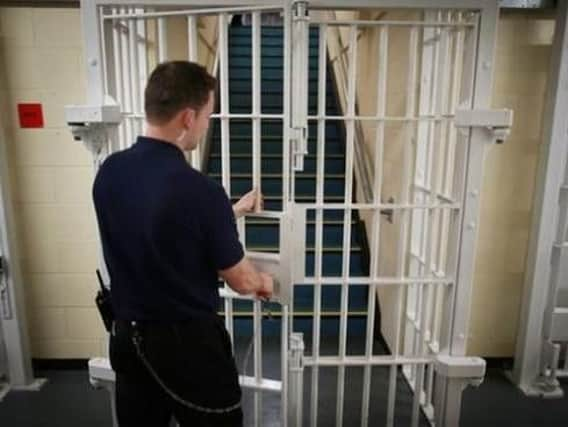Mixed results for Yorkshire's troubled prisons as results of Government's £10m scheme to tackle violence is revealed


HMP Leeds, HMP Hull, HMP Humber, HMP Wealstun, near Wetherby, and HMP Lindholme and HMP Moorland, both near Doncaster, were selected for the blitz on violence and drugs back in August last year, along with Nottingham, Ranby, Isis and Wormwood Scrubs prisons.
Following the scheme, which was launched in March this year, HMP Humber and HMP Wealstun both saw falls in the average number of assaults and prisoners using drugs.
Advertisement
Hide AdAdvertisement
Hide AdHowever, both HMP Hull and HMP Moorland saw slight increases in assaults with HMP Leeds remaining the same.
Drug use levels fell at HMP Leeds, but rose at both HMP Lindholme and HMP Moorland.
They remained the same at HMP Hull.
The figures show assaults at HMP Hull rose from an average of 27 between March and May this year, to 29 between April and June.
HMP Moorland increased from 18 to 23, while Leeds remained the same at 46.
Advertisement
Hide AdAdvertisement
Hide AdHMP Humber saw the number of assaults fall from an average of 29 between March and May this year, to 26 between April and June.
Assaults at HMP Wealstun reduced from 33 to 24, while Lindholme fell from 32 to 28.
Measures introduced by the Government have included new scanners, sniffer dogs and repairs to basic infrastructure at all 10 prisons.
Ministry of Justice (MoJ) officials said "tangible results" were expected within 12 months, and then prisons minister Rory Stewart vowed to resign if the campaign failed.
Advertisement
Hide AdAdvertisement
Hide AdLast week, Boris Johnson announced £100 million of investment to boost security and cut crime in prisons.
Prisons minister Lucy Frazer said: "I am encouraged by the results of this bold project to turn around some of our most difficult prisons, which have seen drops in both violence and drug use.
"We are already using what has worked to improve the rest of the estate, spending £100 million on airport-style security to stop the scourge of mobile phones and drugs that fuel crime and disorder in jails.
"Alongside our recruitment of thousands of prison officers and building 10,000 additional prison places, we will continue our relentless drive to protect the public and make prisons places of safety and rehabilitation."
Advertisement
Hide AdAdvertisement
Hide AdThe MoJ said the project will end but will form "part of our continuing efforts to boost safety, security and decency in all prisons".
The figures across the 10 prisons show the rate of assaults per 1,000 prisoners fell from 42.9 in the three months to August last year to 36.1 in the quarter to June - a decrease of around 16 per cent, compared with a drop of roughly eight per cent across all prisons in England and Wales.
The figures suggest the rate of positive drug tests across the 10 prisons roughly halved from 26.5 per cent in August last year to 13.4 per cent in March, although the MoJ report pointed out the number of prisoners sampled was relatively small.
Charlotte Pickles, director of the Reform think tank, said: "These results are very encouraging, and demonstrate that smart, targeted investment can reduce prison violence.
Advertisement
Hide AdAdvertisement
Hide Ad"These findings must now inform how the £100 million promised last week by the Prime Minister is spent.
"Violence is a critical issue across the prison estate. The 10 prisons are a small proportion of the estate, and do not include some of the worst in the country, which must now be the focus of attention.
"It is also vital that the Government does not undermine this progress through its ill-conceived sentencing proposals.
"Locking more people up for longer will create more demand in an already overstretched system, further exacerbating violence. Prison must always be a last resort."
Advertisement
Hide AdAdvertisement
Hide AdFigures released last month by the MoJ showed assaults in prisons across England and Wales hit a new high of 34,425 in the 12 months to March, up 11 per cent from the previous year, and a rate of 415 incidents per 1,000 prisoners.
Data compiled by Inquest found there were 34 deaths across the 10 prisons involved in the pilot in the 12 months before the project was launched, while the charity's analysis of MoJ figures found 41 deaths in the 11 months since the start of the scheme.Deborah Coles, director of Inquest, said: "The 10 prisons project was fundamentally flawed in its scope and analysis of the prison crisis.
"It was a complacent, simplistic response to a complex problem. It was not about safety, but about security and control."
"The relentless focus on the issues of violence and drugs may have brought some short-term relief in eight (of 188) prisons.
"However, it has abjectly failed to guarantee the health and safety of prisoners or reduce deaths according to the MoJ's own data."
